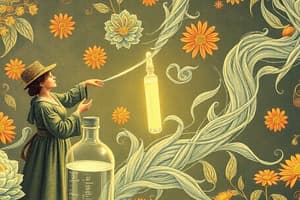Podcast
Questions and Answers
Who is credited for isolating pathogenic microorganisms from diseased organisms?
Who is credited for isolating pathogenic microorganisms from diseased organisms?
- Joseph Lister
- Edward Jenner
- Francesco
- Paul Ehrlich
- Robert Koch (correct)
What are the eight levels of Taxonomic Hierarchy?
What are the eight levels of Taxonomic Hierarchy?
Domain, Kingdom, Phylum/Division, Class, Order, Family, Genus, Species
What are the five types of functional media used by microbiologists?
What are the five types of functional media used by microbiologists?
General Purpose Media, Enriched Media, Selective Media, Differential Media, Selective & Differential Media
What are the three physical states of media classification?
What are the three physical states of media classification?
What are the two media types in media classification?
What are the two media types in media classification?
What is the definition of a milli (meter)?
What is the definition of a milli (meter)?
What is the definition of a micro (meter)?
What is the definition of a micro (meter)?
What is the definition of a nano (meter)?
What is the definition of a nano (meter)?
What is the definition of a pico (meter)?
What is the definition of a pico (meter)?
What does filamentous refer to?
What does filamentous refer to?
Who developed a technique to isolate pathogenic microorganisms?
Who developed a technique to isolate pathogenic microorganisms?
What is the role of taxonomic hierarchy in biology?
What is the role of taxonomic hierarchy in biology?
Which microbiologist demonstrated that microorganisms are everywhere and developed the rabies vaccine?
Which microbiologist demonstrated that microorganisms are everywhere and developed the rabies vaccine?
What did Robert Koch accomplish?
What did Robert Koch accomplish?
Which classification system was introduced by Carolus Linnaeus?
Which classification system was introduced by Carolus Linnaeus?
Francesco Redi is known for proving spontaneous generation.
Francesco Redi is known for proving spontaneous generation.
What bacterium did Theodor Escherich discover?
What bacterium did Theodor Escherich discover?
Match the following microbial characteristics with their description:
Match the following microbial characteristics with their description:
Which of the following is used to decrease infection by microorganisms?
Which of the following is used to decrease infection by microorganisms?
Alexander Fleming discovered penicillin in 1928.
Alexander Fleming discovered penicillin in 1928.
What significant system did Carl R. Woese create?
What significant system did Carl R. Woese create?
Which two microbiologists are credited with the early beginnings of the germ theory of disease?
Which two microbiologists are credited with the early beginnings of the germ theory of disease?
Pasteurization is best used to kill unwanted microbes in ______________.
Pasteurization is best used to kill unwanted microbes in ______________.
Which type of microorganism can be classified as prokaryotic?
Which type of microorganism can be classified as prokaryotic?
Flashcards are hidden until you start studying
Study Notes
Microbiology Key Figures and Concepts
-
Louis Pasteur: Demonstrated ubiquitous microorganisms, disproved Spontaneous Generation, discovered fermentation by yeast, linked spoilage to microbes, developed Pasteurization, rabies vaccine, and invented the swan-neck flask.
-
Robert Koch: Pioneer of techniques to isolate pathogens; isolated Bacillus anthracis, tuberculosis bacillus, and Vibrio cholerae. Developed Koch's postulates, awarded Nobel Prize in 1905.
-
Carolus Linnaeus: Introduced the system of Binomial Nomenclature for scientific classification in 1735.
-
Francesco Redi: Discredited spontaneous generation by demonstrating flies generate maggots on decaying meat in 1668.
-
Theodor Escherich: Discovered Escherichia coli, critical in understanding gut microbiota.
-
Binomial Nomenclature: Organisms are classified by genus and species, with genus capitalized and both italicized.
-
Disinfectants: Phenol (carbolic acid) was the first used widely to reduce infections caused by microorganisms.
-
Alexander Fleming: Discovered penicillin in 1928, leading to modern antibiotics.
-
Carl R. Woese: Introduced the three-domain system (Archaea, Bacteria, Eukarya) in 1990.
Microbial Classification
-
Three Domains: Archaea, Bacteria, and Eukarya; protozoa belong to Eukarya.
-
Microorganism Categories: Include Bacteria, Archaea, Fungi, Algae, Protozoa, Helminths, and Viruses.
-
Bacteria: Prokaryotic, unicellular, with cell walls made of peptidoglycan.
-
Fungi: Eukaryotic, non-tissue forming, spore-reproducing, with cell walls of chitin.
-
Algae: Eukaryotic, photosynthetic organisms; part of phytoplankton.
Environmental Microbiology
-
Archaea: Prokaryotic, unicellular, can be extremophiles (halophiles, acidophiles, alkaliphiles, hyperthermophiles).
-
Microbial Survival: Endospores protect bacteria in harsh conditions; fimbriae facilitate adherence.
Microscopy and Techniques
-
Koch's Postulates: Guidelines to establish a causative relationship between a microbe and a disease (isolation, culture, infection, and re-isolation).
-
Golden Age of Microbiology (1857-1914): Establishment of germ theory, use of disinfectants, surgical improvements, and vaccination development.
-
Gram Stain: Differentiates bacteria into gram-positive (thick peptidoglycan) and gram-negative (outer membrane).
Microbial Structure and Function
-
Cellular Structures:
- Capsule: Gelatinous layer in some bacteria.
- Fimbriae: Attachment structures on bacteria.
- Plasmids: Circular DNA in bacteria, contains additional genes.
-
Transport Mechanisms:
- Facilitated Diffusion: Process where glucose crosses cell membranes without energy.
- Active Transport: Requires energy to transport substances against a gradient.
Taxonomy and Classification Systems
-
Five Kingdom System: Proposed by Robert H. Whitaker; includes Prokaryote, Protista, Fungi, Plantae, Animalia.
-
Taxonomic Hierarchy: Ranks include Domain, Kingdom, Phylum/Division, Class, Order, Family, Genus, and Species.
Measurements in Microbiology
- Micrometers (um): One millionth of a meter.
- Nanometers (nm): One billionth of a meter.
- Millimeters (mm): One thousandth of a meter.
Studying That Suits You
Use AI to generate personalized quizzes and flashcards to suit your learning preferences.




